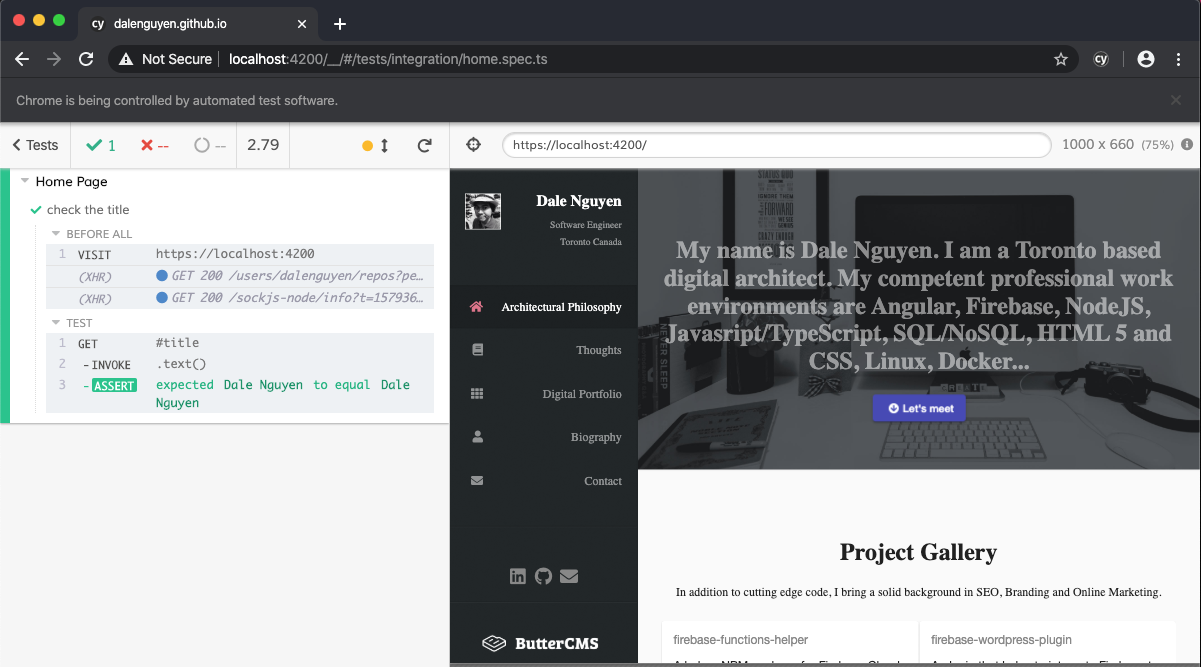
Angular End To End (e2e) Testing With Cypress.io
An End to End Test is a methodology used to test an application from a user's perspective. It ensures that the application behaves as expected from the beginning to the end. I usually run it after fixing a bug or adding new features to ensure that nothing breaks.
What is Cypress.io?
Cypress is a next generation front end testing tool built for the modern web. It addresses the key pain points developers and QA engineers face when testing modern applications.
Cypress is most often compared to Selenium; however, Cypress is both fundamentally and architecturally different. Cypress is not constrained by the same restrictions as Selenium.
This enables you to write faster, easier and more reliable tests.
Install Cypress
First, you need to install Cypress as a dev dependency in your project.
npm install cypress --save-dev
After installing, you need to add a script to your package.json file to run Cypress.
"scripts": {
"cypress:open": "cypress open"
}
Create a Test File
Now, let's create a test file. Create a new file in the cypress/integration folder. For example, home.spec.js.
describe('Home Page', () => {
it('should visit the home page', () => {
cy.visit('http://localhost:4200')
})
it('should contain welcome message', () => {
cy.visit('http://localhost:4200')
cy.contains('Welcome')
cy.contains('Welcome')
})
})
- This is a sentence.
+ This is a longer sentence.
- const foo = 'bar';
+ const foo = 'baz';
Run the Test
Before running the test, make sure your Angular application is running on http://localhost:4200.
npm run cypress:open
This will open the Cypress Test Runner. Click on the home.spec.js file to run the test.
Advanced Testing
Let's create a more advanced test. We'll test a login form.
describe('Login Form', () => {
beforeEach(() => {
cy.visit('http://localhost:4200/login')
})
it('should display login form', () => {
cy.get('form').should('be.visible')
})
it('should require email', () => {
cy.get('input[type="submit"]').click()
cy.get('.error-message').should('contain', 'Email is required')
})
it('should require password', () => {
cy.get('input[name="email"]').type('test@example.com')
cy.get('input[type="submit"]').click()
cy.get('.error-message').should('contain', 'Password is required')
})
it('should login successfully', () => {
cy.get('input[name="email"]').type('test@example.com')
cy.get('input[name="password"]').type('password123')
cy.get('input[type="submit"]').click()
cy.url().should('include', '/dashboard')
})
})
Cypress Configuration
You can configure Cypress by creating a cypress.json file in the root of your project.
{
"baseUrl": "http://localhost:4200",
"viewportWidth": 1280,
"viewportHeight": 720
}
With this configuration, you can simplify your tests:
describe('Home Page', () => {
it('should visit the home page', () => {
cy.visit('/')
})
})
Example: Testing a Todo App
Let's look at a real-world example of testing a Todo application:
describe('Todo App', () => {
beforeEach(() => {
cy.visit('/')
})
it('should add a new todo', () => {
const todoText = 'Buy groceries'
cy.get('input.new-todo').type(`${todoText}{enter}`)
cy.get('.todo-list li').should('have.length', 1)
cy.get('.todo-list li').first().should('contain', todoText)
})
it('should toggle a todo', () => {
const todoText = 'Buy groceries'
cy.get('input.new-todo').type(`${todoText}{enter}`)
cy.get('.todo-list li .toggle').click()
cy.get('.todo-list li').should('have.class', 'completed')
})
it('should clear completed todos', () => {
const todoText = 'Buy groceries'
cy.get('input.new-todo').type(`${todoText}{enter}`)
cy.get('.todo-list li .toggle').click()
cy.get('.clear-completed').click()
cy.get('.todo-list li').should('have.length', 0)
})
})
Cypress vs Protractor
Angular comes with Protractor for e2e testing, but Cypress offers several advantages:
- Easier setup and configuration
- Real-time reloading - Tests reload automatically when you make changes
- Time travel - Cypress takes snapshots as your tests run, allowing you to see exactly what happened at each step
- Debugging - Cypress provides better error messages and debugging capabilities
- Automatic waiting - Cypress automatically waits for commands and assertions before moving on

Now you know how to write a simple test script for an Angular project with Cypress. You can check my commit from GitHub.
Hope this helps 🙂